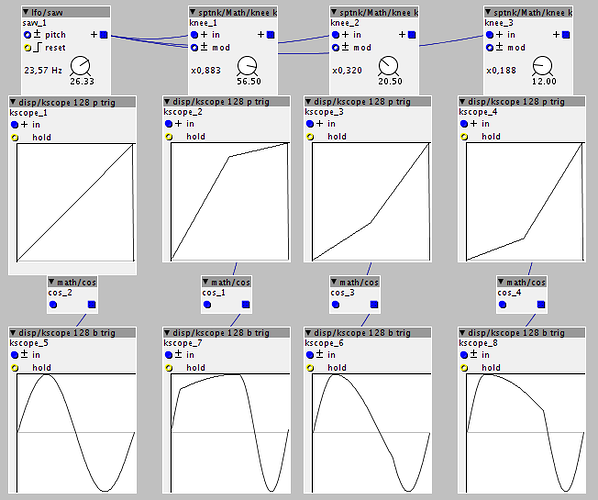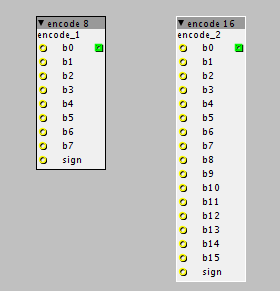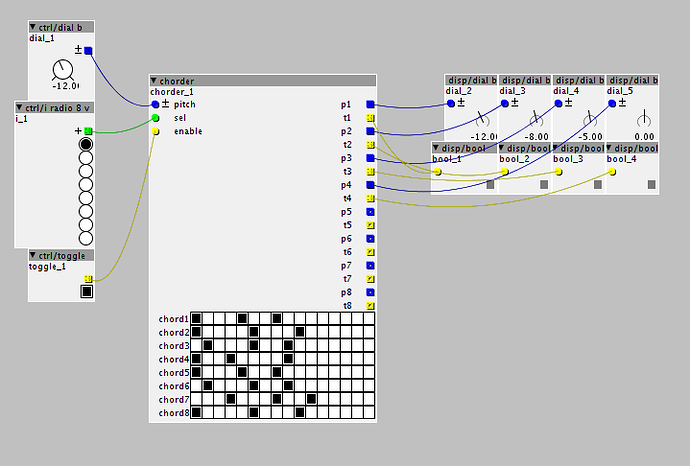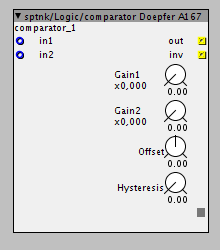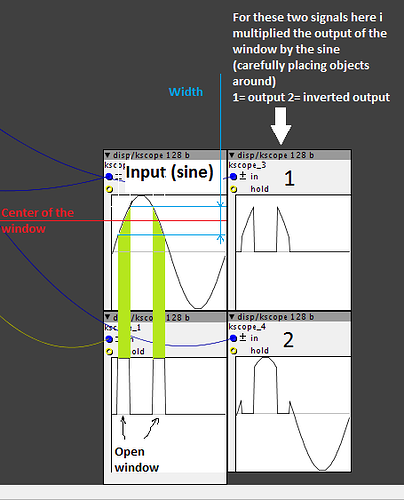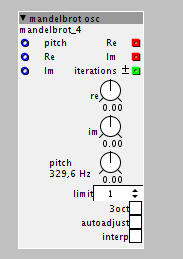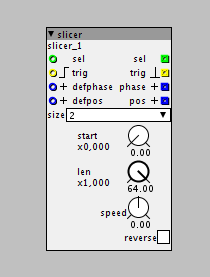Objects
Filter
vowel.axs - 3 bandpass filters in parallel, tuned to specific frequencies in order to emulate vowels. Formant dial (and inlet) morphs between various vowels. The other parameters enable further tweaking of filter.
Sounds quite nice and is fairly light (6% dsp load).
You can find more information eventually in this old topic: https://sebiik.github.io/community.axoloti.com.backup/t/subpatch-vowel-filter/219
table
Various math functions fitted to polynomial expansions and put inside a 16bit sdram table object. Size parameter determines how many samples are stored into the table.
Official topic here: https://sebiik.github.io/community.axoloti.com.backup/t/mathematical-functions-fit-to-polynomial-expansions/1301/7
Inside this category you'll find
arcsin_t.axo -
arctan_t.axo - value determines the x range of the function
arcsinh_t.axo - value determines the x range of the function
crossover_hard_t.axo - value determines the size of the gap
crossover_p_t.axo - value determines the size of the gap
crossover_c_t.axo - value determines the size of the gap
slicer.axo sample slicer, see below for further info
slicer i.axo like the previous, but with intlet controls for parameters.
Osc
vosim.axs - inspired by this topic: https://sebiik.github.io/community.axoloti.com.backup/t/vosim-possible-in-axolotl/1335/16?u=sputnki , it's basically a formant oscillator, best results if pitched down near -24/-36, not really light (8% cpu load)
vosim FM.axs - like the previous, but with integrated fm operator
mandelbrot.osc - Oscillator based on the mandelbrot fractal iteration. Check below for info.
Sequencer
Sequencer 16 v2 - one of my first objects, not really a great object but might be useful to some: more informations here https://sebiik.github.io/community.axoloti.com.backup/t/subpatch-16-step-sequencer/237
fibonacci.axo Fibonacci sequencer. Every time trig is activated, the sequencer goes one cycle forward. At every cycle the output is calculated with the formula o=i1+i2, where i2 is the first preceding output, and i1 is the second preceding output. At reset i1=0 , i2=1 unless i1 and i2 are connected. For example, the normal sequence is 1, 1 , 2 , 3, 5, 8, 13, 21, 34, 55, etc..
fibonacci astarb.axo A variation on the fibonacci sequencer. In this case the output is calculated with o=i1*i2, and the default starting i1 and i2 are 1 and 2. Grows very quickly.
pseudo factorial.axo Another variation on the fibonacci sequencer. In this case the output is calculated with o=i*(i+a+1) , where i is the preceding output. a is provided with inlet_a . At reset if inlet_i0 is disconnected, i=1, otherwise i=inlet_i0.
Grows really quickly, may result in overflowing and therefore unexpected big numbers.
euclid.axo Euclidean rhythm generator. Chainable. Notes specifics the number of active steps, rests the number of rests. Inlet in specifics what step to read, like sel i 16/32 or disp/ibar . If outside the range the default inlet will be outputted (like said objects).
Dynamic algorithm, 10% dsp load worst case with 63 notes and 64 rests.
euclid length.axo Like the prevous, but this time you won't have to fiddle with rests: you just have to specify the length of the pattern (also if you set more steps than the pattern length the sequence will be calculated on the max length.
euclid length out.axo Like the previous, but there's an outlet that outputs an integer which you can decode to get the individual steps (use decode bin 8.axo Maximum pattern length=31 ( i know, it's an odd number.)
chorder.axo Stores 8 chords in memory. See the post below for more informations, this is quite a fat object!
chorder adv.axo Like the previous, but allows to individually pitch up or down chords (basically reduces the need for a pitch cv in)
24ppq to bpm.axo This object can be used to detect the bpm speed of a midi clock signal expressed in 24ppq.
Outlets:
-bpm - outputs the integer part of the bpm
-mill - outputs the fractional part of the bpm
-1000bpm - outputs bpm*100
24ppq to phase64.axo This object generates a phase signal that goes from 0 to 64 in 64 beats (16 quarters) when fed with a 24ppq signal.
24ppq to pos Converts a 24ppq counter signal into different subdivisions: quarters, sixteenths and triplet eights.
Length parameter can be used to set the length (in quarters) before resetting the counter (works exactly like divremc).
Cue parameter offsets the incoming signal by a constant number of ppqs.
24ppqrem outputs the cued and divided 24ppq signal.
maestro.axo Melody sequencer object, see below for more information (it's a very big object)
inlet -> +cue -> divremc -> 24ppqrem -> other outputs
clock out dual Midi clock master, also outputs Midi clock, start, stop, and continue messages on two separate Midi devices.
The secondary device can be switched on or off (when off, the behavior is identical to the midi/out/clock by Johannes).
Based on midi/out/clock by Johannes Taelman.

